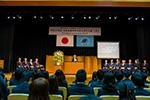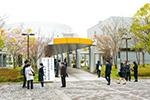2015/04/09
On Monday, April 6, 2015, an entrance ceremony was held in the Millennium Hall.
NAIST eagerly promotes admission of students whether from Japan or overseas with strong basic academic capabilities without being bound to a major field in university as well as researchers, engineers and others currently working actively in society who have clearly defined goals and aspirations for the future as well as strong interest and enthusiasm for research fields. This spring 445 graduate students were granted admission to NAIST.
At the ceremony, Mr. Yoshinori Okuda, the Vice Governor of Nara Prefecture, Mr. Masashi Komurasaki, the Deputy Mayor of Ikoma City, Mr. Hiroshi Koyama, the Executive Director of the Foundation for NAIST, Dr. Shoji Komai, the Head of NAIST Alumni Association were invited as guests. There was a performance of "Busu (The Delicious Poison)", Okura School of Kyogen by the Shigeyama Family.
*Number of Enrollees in April
[Master's Course]
Information Science 129 (11 international students)
Biological Sciences 119 (2 international students)
Materials Science 104 (1 international students)
[Doctoral Course]
Information Science 37 (16 international students)
Biological Sciences 25 (4 international students)
Materials Science 31 (7 international students)
Total 445 (41 international students)
[Congratulatory Remarks to Entering Students, Entrance Ceremony, Spring 2015]
I would like to extend my heartfelt congratulations to 352 master's program students and 93 doctoral program students who entered NAIST today. On behalf of the 200 faculty and 150 staff members of NAIST, I welcome you all. I would like to express my congratulations to the families of the students, as well.
The new students who entered NAIST today include 15 students from 8 countries around the world. I would like to warmly welcome you, the international students who have chosen to study at NAIST, away from your home countries. About 2 weeks ago, 27 international students received their degrees. With your addition, we have a total of 188 international students from 42 countries, accounting for 17 percent of all the NAIST students. Our goal is to accept a number of international students and researchers at each of our 60-odd laboratories in order to internationalize our educational and research environment, and this goal is steadily becoming a reality.
As is often said today, the increase in cross-border mobility of information, people and goods is accelerating economic development around the world. It is therefore important to address global issues such as resource scarcity and climate change in a manner compatible with our economic and social activities, thereby ensuring sustainable development of society. To this end, we must reform the current model of societal development, which simply pursues material affluence. We are thus in an age where there is no precedent or roadmap to follow, which means we must identify new problems to be addressed and help to find creative solutions to these problems.
So far Japanese universities have tended to focus domestically, but today we must internationalize ourselves with a view to the future of the world, so that more students and researchers from around the world will study at Japanese universities and learn about Japanese science and technology, while Japanese students need to be exposed to the demands placed on science and technology at the global level and to the societies of various countries. Against this backdrop, the Ministry of Education, Culture, Sports, Science and Technology (MEXT) launched a program called the Top Global University Project last year. This project is designed to provide priority support for selected universities that focus on increasing their international compatibility, and I am pleased to note that NAIST is one of the universities selected. Utilizing the financial support of this program and other resources, we will make our campus environment even better for international students and create more opportunities for various international interactions among our diverse students with different cultural backgrounds and needs for science and technology. Through this program, we will also further improve our educational programs to connect you directly to a variety of areas of science and technology around the world.
I hope that all of the new master's program students will embark on ambitious new endeavors. You have left your previous institutions and entered NAIST with various aspirations for further studies in your chosen field or to pursue new research areas. Here at NAIST, no matter which laboratory you join or what area of study you have chosen, a great many possibilities are open to you. Shortly, you will be briefed on research projects being undertaken at laboratories in each graduate school, and I encourage you to consider all the possibilities on offer at NAIST, not bound by the knowledge you have acquired and the graduation studies you have completed at your previous institutions. By doing so, you may find intriguing research areas that you have neither encountered nor even thought of. As indicated by our motto, "Outgrow Your Limits," NAIST enables you to pursue new challenges to open up your future.
Now, I would like to explain the background to the foundation of NAIST. In the concept paper to establish NAIST, the guiding mission of our research was described as follows.
"Characteristically, the fields of frontier science and technology have wide-ranging, interdisciplinary dimensions, in which innovative developments are taking place at a very rapid pace. In these fields, new knowledge from fundamental research results in technological developments in very short periods, and technological developments, in turn, become the base of fundamental research and make further progress possible. Thus, high integration of science and technology is more clearly evident than in any other fields. With this in mind, it is crucial to promote interdisciplinary fundamental research that reaches beyond traditional academic divisions in these fields."
The mission of education at NAIST is explained as follows. "With the rapid developments in the areas of frontier science and technology, an important issue for both academic research and industry is the organized fostering of researchers and engineers capable of undertaking the research and development in these fields. Especially in these fields, it is necessary to train diverse human resources with refined fundamental skills to respond flexibly to developments in science and technology, and to continuously pursue new fields of research."
To sum up, NAIST was founded to conduct interdisciplinary research in the rapidly developing fields of frontier science and technology such as information, biological and materials sciences, by integrating science and technology and extending beyond the borders of established areas of studies such as engineering, physical science, agriculture and medical science. With this as our foundation, NAIST develops human resources capable of flexibly responding to developments in science and technology, and continually cultivating new areas of research. NAIST's education and research mission, which has since been revised to include the keyword "to see [the issue] from a global perspective," was pioneering from the outset and continues to represent the ideas necessary for society today.
With enthusiastic research by faculty members from various backgrounds, and through organized graduate school education based on cutting-edge research, NAIST has conferred master's degrees and doctoral degrees on 6,573 and 1,239 students respectively. NAIST's research and educational activities have been evaluated very highly both in objective rankings and in the MEXT's evaluation of national university educational and research results. For example, MEXT is now offering intensive support to 22 Japanese institutions with a track record of outstanding research under its Program for Promoting the Enhancement of Research Universities in order to strengthen research prowess. NAIST was one of the institutions chosen.
I am proud to add that we are one of only 17 Japanese universities selected for both the Program for Promoting the Enhancement of Research Universities and the Top Global University Project I mentioned earlier. You should be proud of being members of one of the most prestigious universities in Japan in terms of both research and education, and I urge you to take advantage of the precious opportunities available at NAIST.
Speaking of our educational and research mission, science and technology today is changing dramatically and being revolutionized, which will eventually bring great changes to society. For example, it has been estimated that in the United States, half of all human jobs will be taken over by machines within the next ten to twenty years, and more than half of American children who have just started elementary school will end up in jobs that do not even exist today after they graduate from university.
In Japan, it is argued that "At the forefront of today's research are breakthroughs in measurement, analysis, and computational technology that are rapidly expanding our understanding of natural and social phenomena. Consequently, scientific research itself is rapidly expanding and is in a constant state of flux, against the backdrop of: ongoing increases in the amount of information and drastic progress in computational science that are bringing about faster information processing speeds; and the development of transportation and telecommunications networks that makes unprecedented speed in the disseminating and sharing of information possible. In broad domains such as life science and materials science, new interdisciplinary and multidisciplinary fields are being developed, and the frontiers of knowledge are being expanded rapidly."
The new keywords for information science are "big data" and "Internet of Things (IoT)." Thanks to the improvement of computers, sensors, and network efficiency, the entire world is now interconnected in real time through the internet, and the integrated use of data around the world is now possible. We are also entering an era where automobiles and various other products are constantly connected to the internet, which will give rise to a new world based on information and communication technologies.
Revolutions in genome DNA sequence analysis technology have allowed us to collect huge amounts of data on the activities of various cells and living organisms including humans. As a result, the focus in bioscience has shifted from understanding various individual processes to understanding how those processes work collectively and diversely in living organisms and how various living organisms mutually affect each other in the earth's environment.
As symbolized by the term "big data biology," we are seeing a paradigm shift in which the statistical analysis of huge amounts of data is leading actual experimental biology. In material science as well, progress in analysis and measurement technology has uncovered a new world of materials and shed light on the behavior of atoms and molecules. This has led to the creation of new materials that were unimaginable twenty years ago, and to new interdisciplinary fields such as chemical biology and materials informatics.
With the convergence of fundamental research and application of its results to society, it has been stated that "As a result of the expansion of the frontiers of knowledge, high quality knowledge is constantly emerging at the forefront of research and it becomes difficult to predict which knowledge will lead to the creation of new social value." I am sure that in ten or twenty years from now when you play leading roles in society, whether as researchers, engineers or otherwise, after completing your studies at NAIST, science and technology will have developed in ways we cannot even imagine today.
Today's global society requires human resources capable of thinking on their own and creating and utilizing new science and technology, even with no precedent or roadmap to follow. In order to help create a new world through the development and application of new science and technology at the forefront of society, I hope you will acquire specialized knowledge and a holistic vision in order to respond flexibly to the quickly developing science and technology and continue exploring new areas of research, while nurturing your interdisciplinary and cross-cultural communication and collaboration skills at NAIST.
Therefore, it is important for you to remain sensitive to the trends in various fields of research and develop the ability to use the results of such research creatively, without being locked into your own area of expertise. While you will all join different laboratories and continue your studies and research at NAIST, you may be able to achieve interesting results by borrowing methods and ideas from other laboratories. NAIST is known for its easy access to all laboratories and graduate schools, so I hope you will interact with people with a wide variety of research interests.
Finally, I hope you will enjoy your life at NAIST in good health, both physically and mentally. In starting your new life here, you will get to meet many people. Build good relationships and personal networks; these will not only expand your range of studies and research, but will also become an invaluable asset for your entire life.
In concluding my message, I hope you will have a successful student life and future beyond.
Congratulations once again on entering NAIST. All members of the faculty and staff welcome you wholeheartedly.
April 6, 2015
Naotake Ogasawara,
President
Nara Institute of Science and Technology







